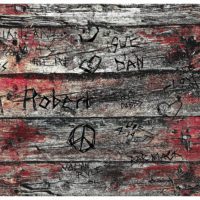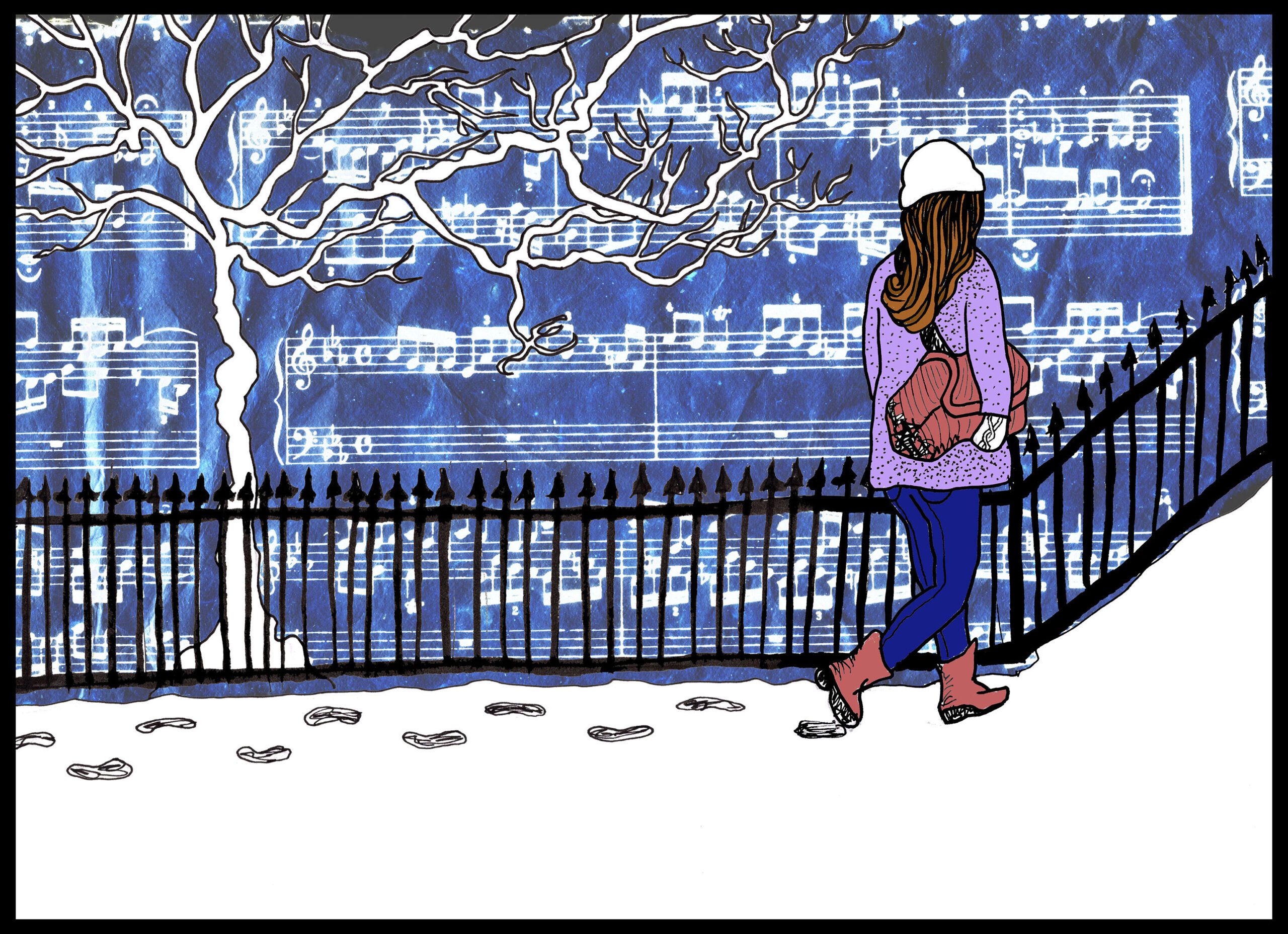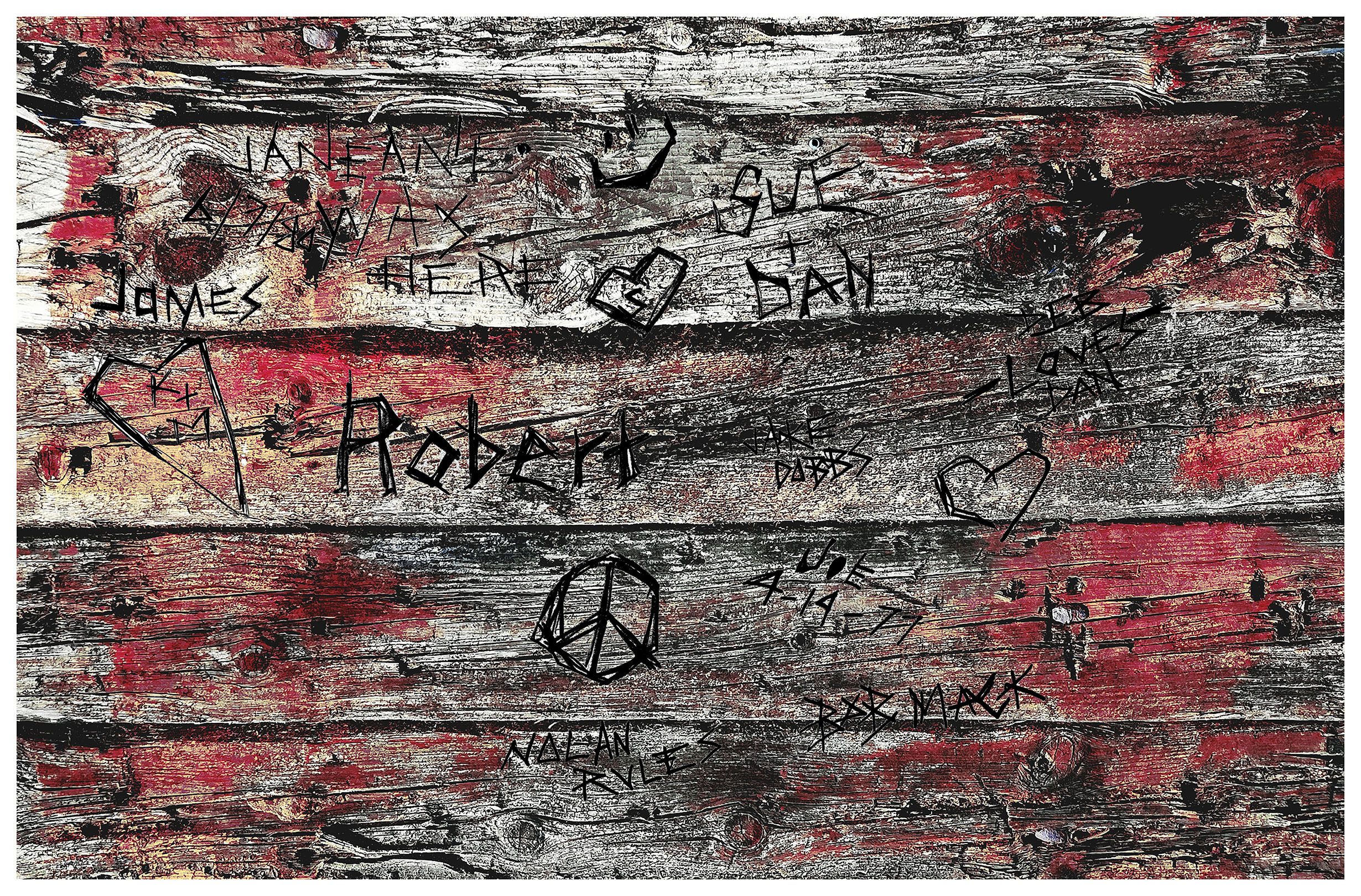Lesson One: By horrible example, a woman learns how not to get killed. I am a teenager, working at a summer camp near Huntsville, Ontario. It is the mid-nineties and I am wearing an orange and green tie-dye Grateful Dead t-shirt and my hair is waist-length and bleached by the sun. It is early in the season and the staff are readying the grounds for when the campers arrive later in the week. Today, I am tasked with searching every cabin on camp for the name of the vilest sexual predator that my country has seen, so that I can sand it away. These were the marks he left behind when he worked as a camp counselor here, about ten years ago. The graffitied cabin walls call a silent roll of everyone who has drifted through this place over the past few decades. Our director decides not to erase the rapist’s name from the official records of previous campers and staff that hang on plaques along the interior walls of the dining hall, but he does not want campers (or staff) seeking out this criminal’s teenage scrawl with their flashlights at night—a man who has recently been convicted of sexually assaulting, torturing, and murdering a series of girls around my age. Armed with a few sheets of sandpaper, it will take me an entire day to scan each cabin wall, rafter, beam, and ceiling for his name.
Polly Stewart is a musical child with a penchant for Burl Ives tunes, some of them ballads warbled across centuries, passing from one (now long gone) songster to the next, wending through the countryside and in and out of towns, until the sung poems crossed the Atlantic on sailing ships, tucked into the repertoires of the European emigrants on board. Slowly, the old songs of knights and kings and castles and maidens were sung out into the deep brush, the endless whiteness, the mountains, and the astonishing heat of a new landscape. Polly and her siblings sit in the backseat of their family car and sing along with Burl as the streetscapes of Salt Lake City slide by their windows. They learn the words and plot lines—veneers of romance, or, coupling—where love is lost, or retained with strength and wit; and yet, even when successful, the women in the ballads never truly seem to get what they want.
Lesson Two: For a woman, stepping outside her house is dangerous. I am twenty-six and living in Kyiv, Ukraine, working as a journalist at an English-language newspaper. It is past midnight and I’ve just left a party in a taxi. The driver lets me off at the corner and I walk over the snow-covered street to the archway that leads into the apartment complex where I live. The light is burned out and the archway is dark, but this isn’t unusual. As I exit into the forested courtyard, a young man appears from my left. He wears a black leather jacket and a black wool cap. He speaks with urgency. I can’t understand him, but I know his behavior is strange. Men, for the most part, do not bother me in Kyiv. If they pay special attention or look at me, it is because I am a foreigner, dressed in American clothes. I am a curiosity, but never an object of desire or harassment. This man is different. He wants something from me; he looks desperate.
He takes my hand in a strong painful grip. I pull away, hard, and free myself. The white mitten that I’ve been wearing falls to the ground. Then, I feel a rush of air, as if a sudden gust of wind has blown from the shadows behind me. I turn slightly to see a blur of movement. It is a second man running towards me from an opposite shadowy corner than the first. Time suspends while I wonder, have I been screaming? Is this man coming to my rescue? It is my last thought before the full-body slam of the runner throws me to the ground. My tailbone bears the initial impact of my fall. Then, the back of my skull bounces off the pavement.
My ears buzz. I struggle, kick, and bite, but the men are stronger. Time slows again, and I have two more thoughts: First, I think, I’m going to die. Second, I think, No, my voice will save me. I am screaming. I don’t know if I am using words in English or Ukrainian or if I am shrieking into the abyss. I think I am saying, “No, no, no.” I might be asking, “Why?”
One man covers my mouth, but I screech through his fingers, tasting the salty sweat of his palm. I am being dragged farther back into the archway where there is no light and I continue to wail. They turn me over onto my stomach and I feel my purse being lifted up over my head. Lying still, I realize that I am alone again. In the darkness the two men disappear instantly, but I can hear the crunch of their footsteps across the snow, receding into the night.
Polly becomes a folk singer in her early teens. She carries her guitar everywhere, as if it is a purse. She imagines a future on stage, singing into a microphone. In these fantasies she is a redhead, although her hair has only ever been wispy shades of brown. She has a second dream, one she’s not sure belongs to her—in it she is a wife, a mother, a homemaker. She likes the boys she dates, but she can’t imagine marrying any of them. Still, she believes her life will mirror the lives of the other women in her family—wives, mothers, educated but ultimately helpers to their husband’s successes. Polly’s two dreams run parallel to each other, but they do not intersect and only one of them seems real.
Lesson Three: A woman’s resources for protection are slim. He was wearing a balaclava, or he was wearing a leather gimp mask that zipped up the front of his face. He wore his shorts around his ankles, or he pulled them aside, or he’d been wearing pants but had removed them. The doorway, where he stood waiting for us, was backlit, or it was spot lit from above. He’d brushed past us as we left the bar. I think our shoulders touched. I think he stopped to grab one of those free entertainment magazines from a bin at the curb. Or, had that been a different person, an innocent bystander who’d unknowingly wandered into the narrative that would become my police report? Maybe this passerby was a lucky decoy as the man readied himself in the doorway, or maybe he was an unexpected annoyance. However the flasher got there, he’d been waiting for me and my friend, Tamara. He’d already spotted us, which means he must have been in the bar with us that afternoon as it slid into early evening. He needed to wait out the man who joined our table and wouldn’t leave because he wanted to tell Tamara that she looked so much like an actor from Coronation Street. I think that man was still in the bar when we left, and, I think his attentions prompted us to head home. So, I don’t think it was him. Although it was impossible to identify the man by his face mask (which was leather or wool) or by his exposed penis (from dropped shorts or baggy ones pulled to the side), so maybe it was the man who’d harassed us in the pub. We hurried away from him, and, on a parallel road, tried to flag down a passing police car to report the incident, but the officers stared blankly at us as they drove by.
Now, two weeks later, there are two young police officers parked near the same bar when I walk by with Tamara and a third friend, Rachel. We’ve just told Rachel the story of that night and, seeing the police car, she urges us to report it.
The two officers seem distracted—maybe they are in the middle of some other case and we’ve interrupted them. They do not get out of their car so we are forced to lean down and tell our story through their open window.
“It happened two weeks ago?”
“We tried to flag down a police car to say something, but they wouldn’t stop,” Tamara says.
“Yeah, well, at that time of night people always try to get rides home,” the officer says. “That’s not our responsibility.”
“We weren’t trying to get a ride home,” Tamara tells them. “We were trying to tell them that a man was exposing himself to women leaving the pub.”
“So, what?” the cop in the passenger seat asks. “Are you scarred for life?”
No one knows what to say. The experience with the flasher was unsettling, but, I am still able to sleep at night. Is this what he means?
One officer smirks; the other one rolls his eyes; then they wave us off.
Stunned, we walk away.
I first learned about the serial rapist and his crimes the summer before, when my mother visited on my day off from camp. We sat in a small town laundromat watching the dryer spin my clothes and she told me how her friend, an editor at a national newspaper, was seeing veteran trial reporters, men who were grizzled and hardened from working the crime beat, return to the newsroom and openly weep. My mother said she couldn’t tell me what she knew, only that it was terrible and that I should be careful. But, how could I avoid being raped and killed? It seemed a matter of luck and circumstance, not something one could evade.
Polly discovers feminism in graduate school and she realizes that she’s seen life thus far through a scrim of patriarchy. In this revelation she sees her mother’s life in a new way. Not as the parent she’d known, but as a poet who’d sacrificed her craft to serve her husband and children; a painter without her brush, who no longer faces her canvas. Polly becomes a scholar, a folklorist who often shrouds her feminist ideology within the patriarchal societies where she does her research, speaking with folk singers and tale tellers, many of whom are women. She does this to keep safe, but also to protect her female sources. Polly is successful—personally (married) and culturally (post-secondary education, feminist)—yet still, sometimes, the dream life rings untrue.
The day after my attack in Kyiv I spend three hours in The Department of Hooligan Affairs at the police station near where I work. A pubescent-looking officer refers to my assailants as the devil, more than once, while we look at hundreds of black-and-white head shots on a computer screen. Any one of these men could have been the culprits, but to me, they all look like different versions of the same white man. I sometimes make a motion to stop the process and re-evaluate one photo or another, just to humour the officer, but I know this is a futile process.
The officer’s shoulders slump as we near the end. I feel a vague guilt for not finding the wanted men. He had seemed so hopeful for a match although I’m not sure why. A woman attacked in the night, a stolen purse, it must happen all the time. The devils remain at large.
After the officers dismiss us, Rachel, Tamara, and I decide to try and report the flasher a second time. We walk to the nearest police station, and, while we are there, we relay how the officers responded to our initial attempt to tell the story. We are given two forms to complete—one for our complaint about the officers and another to report the incident from two weeks before. The next week, I begin a new job at a small non-profit organization and on the first morning a female detective visits my office to question me about the exhibitionist. My new co-workers watch with interest as I greet the policewoman and we step into the hall to speak. After work, I call Tamara to compare notes. She’d seen a leather mask while I’d seen a balaclava. She’d seen shorts around his ankles while I’d seen them pulled to the side. I remember a man brushing swiftly by my shoulder, but he isn’t part of Tamara’s storyline. The details in our accounts varied wildly, and yet the core of both narratives was exactly the same.
Later that week, a second officer calls me at my workplace. He is a superior to the officer who’d rebuffed our initial attempts to tell him about the incident. He is warm, and he lets me know that he’s on my side. He tells me that no one should be chastised for reporting a crime. He agrees that it was inappropriate for the officer to ask if we’d been “scarred for life.”
“But, I mean, now what?” he asks, in his gentle, even tone. “The officer is sorry, and he won’t do this again. He’s been reprimanded. But, what do you want me to do?”
I don’t know what to say. He interrupts my silence.
“I guess what I’m asking, is, do you want him to apologize to you in person, or, in writing, or, what? Do you want this man to lose his job? He’s got a family, but, you know, if that’s what you want.”
He remains silent now, waiting for my response.
What I say and what I want do not connect.
After graduate school Polly is hired in the English Department at Salisbury College in Maryland where she teaches courses on medieval studies and folklore. She continues her fieldwork, and she keeps singing. In the late 1980s she trains her gaze on her beloved folksongs, those ballads she’d first trilled from her backseat perch in the family car. Collectively, they are known as the Child Ballads, sung poems rooted in the oral tradition of the British Isles and dating back to the fifteenth century. Just as we associate fairy tales with the Brothers Grimm, these ballads are named for their collector, nineteenth century Harvard English professor and folklorist, James Child. He was the first to address these folk songs with a scholarly eye and he organized them into ten published volumes, assigning each ballad a number to facilitate future study.
The action in these tales is in present-tense and immediate, the past a vague and unmentioned country. The stories focus on a central event and tend to begin at the height of the action—an incident which is, almost always, violent. These are sorrowful songs where women are raped, punished to death for loving the wrong man, abducted by vicious relatives and strangers, and burned at the stake for affairs of the heart. The women in these ballads exist as plot points in relation to men.
As Polly studies the narratives that journey through each lament she stops, lifts her head, listens, and, in a radical move, she looks to the singers—the Appalachian women who gleaned these songs from their settler-ancestors—and she sees something that no one else has noticed. There are messages, she realizes, in the songs the female singers choose to pull from their repertoires. The stories within stand as warnings to the younger women in the audience who live, as Polly had lived, within patriarchy’s walls. The singers’ missives were coded, but clear: It is dangerous for a woman to step out of her house; a woman’s resources for protection are slim. “By horrible example,” Polly writes in the papers she eventually publishes on the subject, “a woman learns how not to get killed.”
In an email exchange, nearly fifteen years later, I ask Rachel what she recalls from the night we encountered the police officers. Her memories are fairly similar to mine, except for a crucial part of the story that I’d forgotten. Around the same time that the man had followed me and Tamara from the bar and exposed himself, there had been a string of nearby assaults—one woman had been stalked home and attacked on her front lawn, another had been kidnapped and assaulted over the course of a week.
“That’s why I thought it was important to report the flasher,” she wrote.
In 2004 there were 2,723 sexual assaults in our city, a number that includes the masked man who followed me and Tamara from a bar and exposed himself in a lit doorway. Exhibitionists tend to escalate to more dangerous, sexually deviant behavior, but it’s impossible to know if the man we encountered went on to commit further crimes.
Lesson 4: Women who live together are at risk of harm. Polly’s article, “Lessons for Female Success in the Child Ballads,” is published in the early 1990s in a landmark collection on the intersection of feminism and folklore, Feminist Messages: Coding in Women’s Folklore. There is one line, in parenthesis, nearly an aside, and so short that it might be overlooked, where Polly notes that only one ballad features two women and no man, and, that the protagonists, Bessy Bell and Mary Gray, meet a mutual, fateful end. In the sung poem, the two women run away together and build a bower in the woods, but, in what is perhaps a mournful warning to those who flout sexual norms, they succumb to the plague. In some versions a young man is besotted by one of the women and when he brings food to their secluded bower and is rebuffed, he unintentionally passes on the disease. In others, the culprit of their demise is an infected necklace, likely from the aforementioned suitor. Bessy and Mary are buried together: a small consolation.
Just as the balladeers avoid any sing-song side-eye, never editorializing the narrative, Polly’s summary of the ballad of Bessy Bell and Mary Gray provides no context, only basic plot details; in her retelling she remains objective. She offers the story, but leaves the reader to tease out the meaning. This lesson for female success is implied.
I leave Ukraine after living there for nine months and while I never see them again, I conjure the two men from the courtyard often. I think of them when I rise too quickly from a hard-seated chair, sending a buckshot of pain up my back. Each time I am pregnant the two faceless attackers walk step-in-step with me as my injured tailbone creaks under my heft and sway. I pass them in the shadows of dusk when I’m walking home from the library at night, and sometimes I can hear their footsteps, growing fainter, pitter-pattering into the darkness. They are the sinister, unlikable companions that I cannot shake.
Polly shares her coming out story in a 2011 interview on Utah Public Radio, a tale that unravelled slowly over nearly forty years, but which is wrapped up in a swift four minutes of tape.
“I went clear until 1991 before I came out at work,” she tells the interviewer. “I waited until I was promoted to full professor, and then for another six years after that.”
It is through ballad that I meet Polly Stewart on the page. I am in the fall semester of graduate school when I read “Lessons for Female Success.” I read my life stories into the ballads, awakened by Polly’s text. It is the first time my life intersects with my scholarly work as a folklorist. It is a moment of crystallization. This is the text I read and re-read and return to years later, and, sometimes, even dream about.
Polly had come out as a lesbian in her professional life by the time Feminist Messages was published in 1993, but, the genesis for this collection dated back to 1987, so it’s possible that her mention of Bessy Bell and Mary Gray was her own coded message to readers, embedded in her academic work. She was restricted by the confines of the patriarchy, the ivory tower, homophobia, intolerance, and fear. At the time, gay and lesbian studies had just began making their ways into the halls of academe, and Queer Theory was in its infancy.
Later, in the short audio clip from the radio show, Polly talks about her work with LGBTQ students, how she’d formed covert coping groups, had quiet, important conversations.
“It was all extremely secret, with code names and secret signals and stuff like that,” she said. “People were just terribly, terribly afraid.”
Polly Stewart died in 2013 when she was seventy years old. Former students sent messages into the universe thanking her for the space to be themselves, for walking ahead and making way, for taking them on field trips to celebrations and marches, to see what was possible for LGBTQ youth in larger, urban centers.
Folk singers lamented her demise when she passed. Folklorists busied themselves in paying tribute and founding a prize in her name, one that would allow an emerging scholar to attend their annual conference, in particular one whose research focused on feminism and folklore. This was her final lesson for female success: that women’s stories, feminist stories, are important, and need to be told—retold, even—especially the dark tales of repression and sexual violence.
I spend the day looking for and then erasing the murderer’s signature, which is more emotional and laborious than I’d imagined. The last name I remove is over the bunk where I sleep and, before eviscerating him from the room, I have a friend take my portrait underneath his signature, me pointing upwards, sandpaper in hand. I want to record this act of revision. Not for him, but for the women and girls he raped, murdered, and disappeared, and for me, so I can remember this day. Then, I scour the wall clean.
Years from now, in the intangible space of the Internet, a place my younger self could never have imagined, someone will post an anonymous message on Reddit about that day:
“[I] worked at a summer camp that [ ] used to work at. It’s tradition to always sign your bunk, so his name was all over the cabins. Since most Canadians know the story, the camp had to go and try to find each of his signatures and sanded them all down to not remind the campers and counselors that he used to sleep where they were sleeping.”
This small paragraph reads like a legend. As if the tale were a frightening campfire story about a tragedy that took place in the past, complete with unthinkable acts of violence and a lingering boogie man who haunts each new generation, lurking in the memories of the cabin walls. I will search for myself in this paragraph, but I won’t find any hint of the day I spent sanding the monster’s scrawl. I am nowhere, but despite having erased his marks, he is everywhere. He has scarred for life.
***
Rumpus original art by Genevieve Tyrrell.








